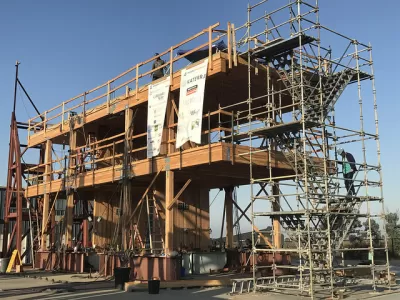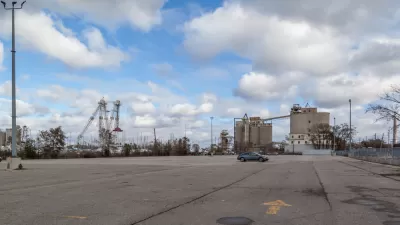Quayside, Sidewalk Labs' smart city in Toronto, calls for ten tall buildings made entirely of wood. Here's why proponents think mass timber is a good idea, and what obstacles stand in its way.

"In most U.S. cities, mass timber buildings, and specifically tall mass timber buildings, are a rarity, if they exist at all," Kira Barrett writes. But Sidewalk Labs' ambitious plan for a Toronto smart city called Quayside includes plans for ten of them. Barrett discusses the nature of the building material, which often consists of cross-laminated timber (CLT) panels, and its pros and cons.
To begin with the positives, proponents cite mass timber's capacity for carbon sequestration: one advocacy organization argues that a site with no building at all has a higher carbon footprint than one with a CLT structure. Mass timber buildings also weigh less than concrete and steel, reducing risk during seismic events.
But several factors hold mass timber back, the most obvious being the perception that wooden buildings are more prone to fire damage (even though engineered wood such as CLT mitigates some of that risk). There's also the question of access to timber for cities far from forests, the need to build out CLT production facilities, and a general lack of familiarity with the material on the part of architects and designers.
Its novelty means mass timber isn't included in the International Building Code, meaning that "construction with this material currently involves years of research, development and testing to make special state and city exceptions, on top of the already intensive construction process."
FULL STORY: Sidewalk Labs is building a smart city entirely of mass timber. What could go wrong?

Study: Maui’s Plan to Convert Vacation Rentals to Long-Term Housing Could Cause Nearly $1 Billion Economic Loss
The plan would reduce visitor accommodation by 25,% resulting in 1,900 jobs lost.

North Texas Transit Leaders Tout Benefits of TOD for Growing Region
At a summit focused on transit-oriented development, policymakers discussed how North Texas’ expanded light rail system can serve as a tool for economic growth.

Why Should We Subsidize Public Transportation?
Many public transit agencies face financial stress due to rising costs, declining fare revenue, and declining subsidies. Transit advocates must provide a strong business case for increasing public transit funding.

How to Make US Trains Faster
Changes to boarding platforms and a switch to electric trains could improve U.S. passenger rail service without the added cost of high-speed rail.

Columbia’s Revitalized ‘Loop’ Is a Hub for Local Entrepreneurs
A focus on small businesses is helping a commercial corridor in Columbia, Missouri thrive.

Invasive Insect Threatens Minnesota’s Ash Forests
The Emerald Ash Borer is a rapidly spreading invasive pest threatening Minnesota’s ash trees, and homeowners are encouraged to plant diverse replacement species, avoid moving ash firewood, and monitor for signs of infestation.
Urban Design for Planners 1: Software Tools
This six-course series explores essential urban design concepts using open source software and equips planners with the tools they need to participate fully in the urban design process.
Planning for Universal Design
Learn the tools for implementing Universal Design in planning regulations.
City of Santa Clarita
Ascent Environmental
Institute for Housing and Urban Development Studies (IHS)
City of Grandview
Harvard GSD Executive Education
Toledo-Lucas County Plan Commissions
Salt Lake City
NYU Wagner Graduate School of Public Service




























